Traffic Cameras: Providing the Whole Picture
Our roads are now watched over by a bewildering array of different cameras. There are traffic enforcement cameras for monitoring red light infractions, stop signs, HOV lanes, bus lanes, right-on-red violations, and vehicles exceeding speed limits; toll cameras that collect fees for lanes, bridges, and congestion charges; and other cameras that work to monitor license plates, pollution, railway crossings, and more. Every week, countless articles and blogs are published questioning the wisdom and motives surrounding many of these cameras, all commonly (and confusingly) referred to as “traffic cameras.” There is one category of “traffic cameras”, however, that everyone can agree benefits both the authorities and the driver, and that is the roadside cameras installed to monitor current road traffic and weather conditions.
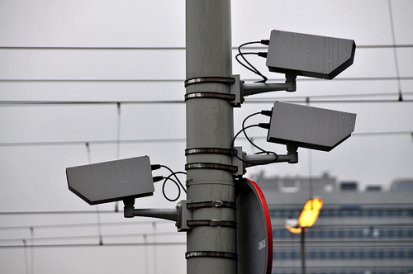
A bewildering variety of cameras watching our roads, by FaceMePLS on flickr.
Used within government traffic control centers and often made available to the public via the web and mobile apps, these traffic cameras can help drivers save time, money, and even their wellbeing. Traffic cameras provide a helpful eye on the road allowing drivers to “know before they go” –and in some cases, while they’re already on the go. Governments around the world spend millions of dollars on implementing and maintaining these traffic cameras because they know that the cameras can help mitigate traffic jams and even save lives.
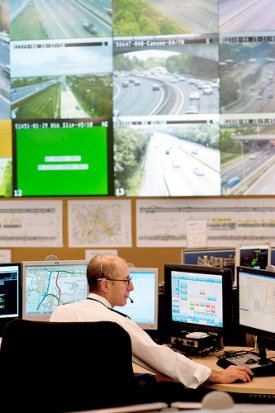
A typical traffic control center, by Highways England on flickr.
Flow data, already a popular and established service on navigation devices, map widgets, and mobile devices, uses speed data from millions of mobile and road-embedded devices and displays the information as the ubiquitous coloured lines overlaid on road maps. Flow data is invaluable for indicating what is happening –a traffic slowdown, for example— but the addition of traffic cameras can show why. Perhaps there’s a major incident that will keep traffic at a standstill for hours; possibly the road is flooded, icy, or freshly covered in snow; or maybe it’s simply a matter of rush hour volume – traffic cameras can, quite literally, display the whole picture.
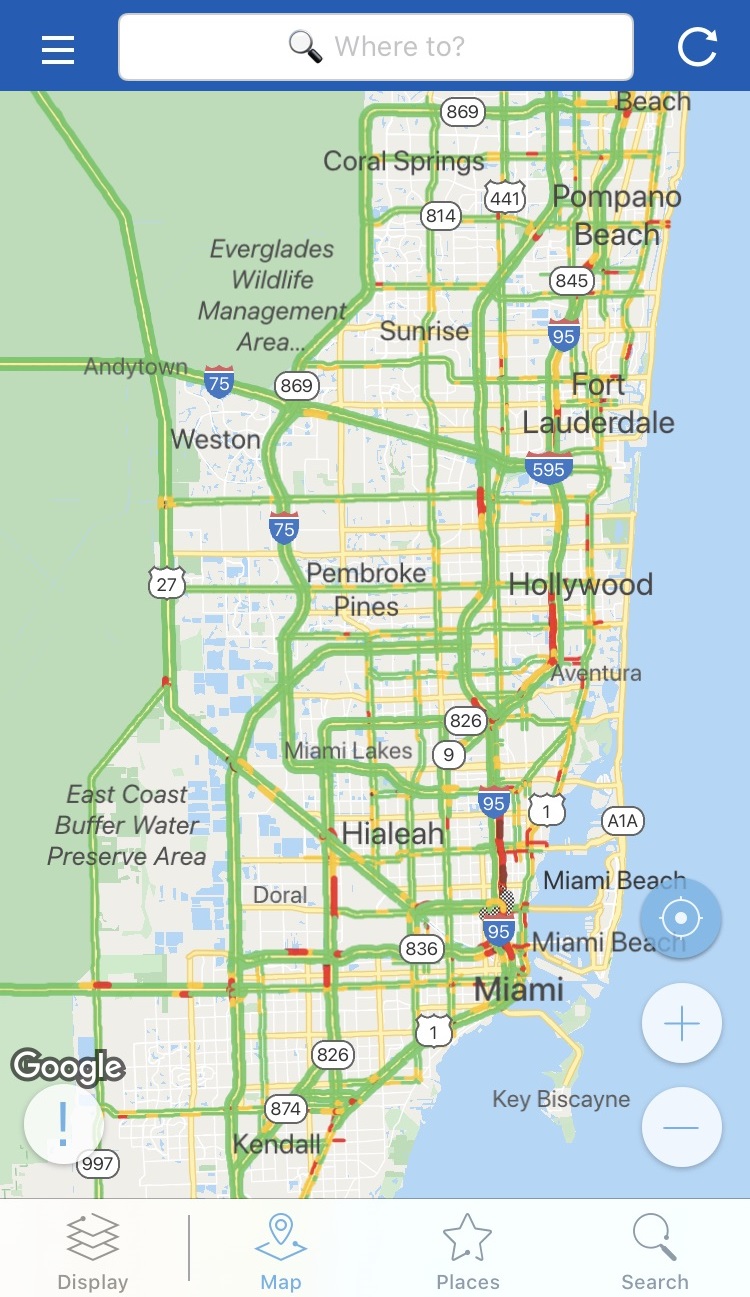
Flow data from INRIX Traffic for iOS.
This difference in data can be critical to ground-truth accuracy. Chris Cooper, President at Vizzion, leading supplier of worldwide traffic camera data to several major traffic application providers, explains: “Traffic cameras add value to flow information. I often find myself in situations where the map shows no congestion, but the cameras reveal the whole story, such as a road that’s impassable due to severe weather, or a road that’s closed due to a police incident.”
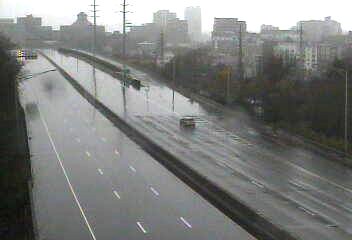
A road with no congestion, but impassable due to flooding during Superstorm Sandy (from NYDOT).
Traffic cameras also often update at a faster rate than flow data. While flow data updates are a matter of minutes, traffic camera update frequencies in top North American markets are often 30 seconds or less. Some markets even offer live video streaming or image update frequencies of half a second or less. “Cameras can often give early warning of an incident, or advance notice that an incident has cleared” says Cooper.
Authorities and customers alike see the value in traffic cameras. In an 2014 article from The Province, a Canadian newspaper, government forecaster David Jones states that “real-time weather pictures from roadside webcams will save lives,” because, “people can find out if their route is safe –or if they should wait to travel." Departments of Transportation worldwide continue to rapidly expand their camera networks and the public is noticing them, too – DOT camera websites receive millions of visitors each month, and MapQuest, one of the companies which rely on Vizzion data and services, saw a turnaround in visitor traffic after adding traffic cameras to their maps.
It’s not just regions with severe weather that benefit from traffic cameras; every major metropolis in the world has productivity-killing congestion issues. The 2019 Urban Mobility report claims that traffic jams cost Americans a total of $166 billion per year. Customers demand traffic cameras because they can help simplify the decisions of when and what route to travel. For DOTs, media, automotive companies, fleet-trackers, application developers, and the public, traffic cameras are a smart investment.
About Vizzion
Vizzion is the leading provider of road imagery for traffic, weather, road condition, and safety operations and applications. Through partnerships with over 200 different transport agencies and on-vehicle camera providers, Vizzion offers live feeds from over 100,000 cameras in 30+ countries. Both on-vehicle and roadside traffic camera services are available through Vizzion’s flexible API and turnkey Video Wall application. Vizzion’s content is trusted by major apps, map providers, broadcasters, fleets, and automotive organizations. Contact busdev@vizzion.com for more information.
Articles
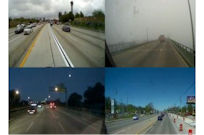
Vizzion Announces New Platform Providing Massive Network of Live On-Vehicle Imagery
Vizzion's new platform will give access to on-vehicle cameras—producing live imagery as they travel.
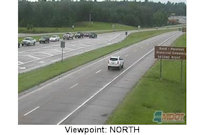
Vizzion Uses Image Analysis to Enhance Data Accuracy and Detect Low-Visibility Conditions
Vizzion's image analysis algorithms create a better end-user experience for its customers by detecting and automatically removing bad images, enhancing impaired images, detecting viewpoints, and other features.
Applications

Mercedes-Benz leads the automotive technology industry with the release of mbrace2, the first product to enter the market with traffic cameras directly integrated by an auto OEM.

Microsoft has selected Vizzion for worldwide traffic camera imagery in Windows 10 and Bing Maps. This feature complements existing traffic flow data and incident data, and allows users to visualize up-to-the-minute road conditions.

The Traffic Operations Center at HERE Technologies uses Vizzion's Desktop Video Wall to locate and report on real-time traffic incident information around the world.